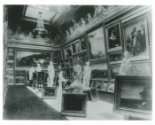Third version, offered at auction, New York, 1887

The picture gallery at the Stewart mansion, G. W. Sheldon, Artistic Houses (New York: D. Appleton, 1884).The picture gallery at the Stewart mansion, G. W. Sheldon, Artistic Houses (New York: D. Appleton, 1884).

Catalogue of the A. T. Stewart Collection (New York: American Art Association, 1887), 176. Catalogue of the A. T. Stewart Collection (New York: American Art Association, 1887), 176.

Catalogue of the A. T. Stewart Collection (New York: American Art Association, 1887), 177.Catalogue of the A. T. Stewart Collection (New York: American Art Association, 1887), 177.

“The Stewart Statues: Bidders Grow Silent and the ‘Greek Slave’ Is Not Sold,” New York Times, April 1, 1887, 1.“The Stewart Statues: Bidders Grow Silent and the ‘Greek Slave’ Is Not Sold,” New York Times, April 1, 1887, 1.

“Close of the Stewart Sale,” New York Tribune, April 1, 1887, 5.“Close of the Stewart Sale,” New York Tribune, April 1, 1887, 5.
Third version, offered at auction, New York, 1887
When Cornelia Stewart died in 1886, Henry Hilton (1824–99), a former judge and longtime confidant of the Stewarts, became executor of the vast estate. The art collection was put up for auction, but most of the Stewart statues, including The Greek Slave, failed to meet their reserve prices. They were bought by Hilton and remained at the Stewart mansion until 1890. (See Martina Droth’s essay.)




